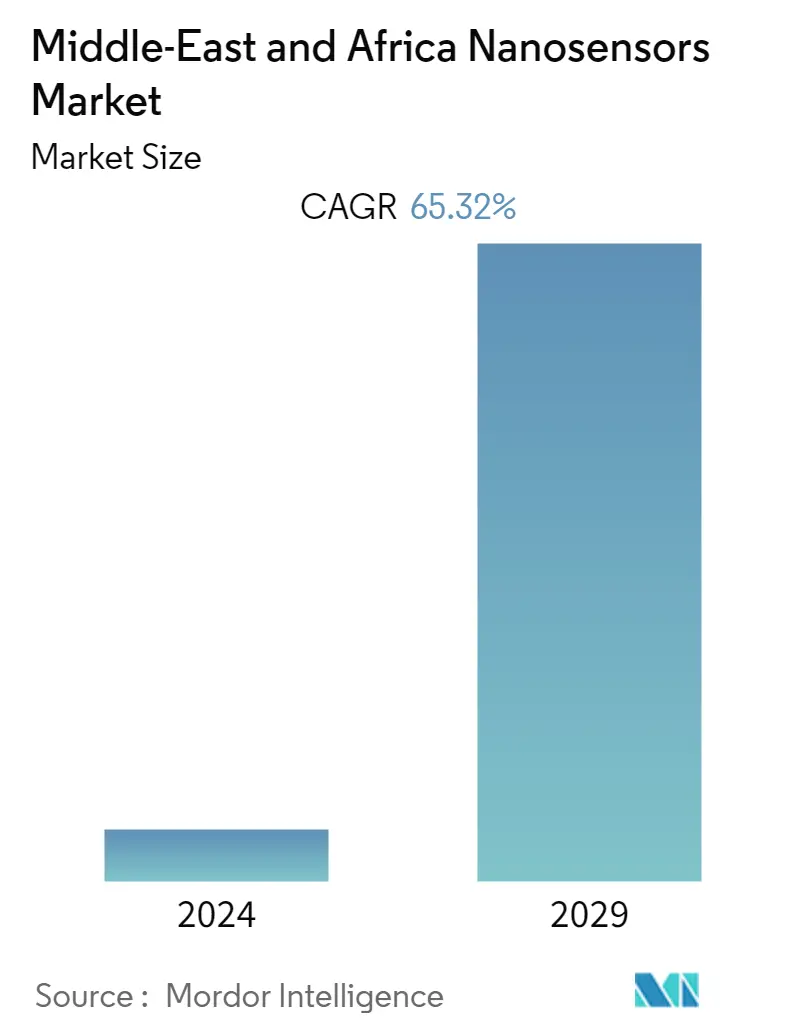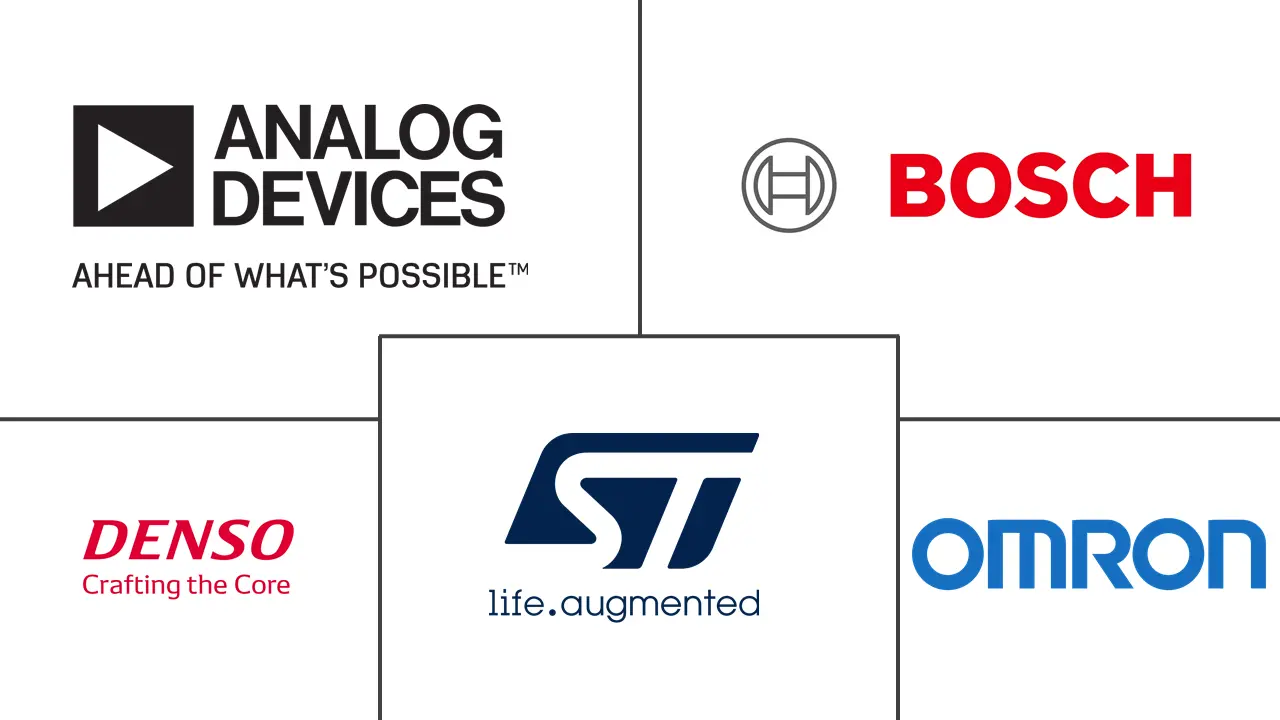Market Size of Middle-East and Africa Nanosensors Industry

| Study Period | 2019 - 2029 |
| Base Year For Estimation | 2023 |
| Forecast Data Period | 2024 - 2029 |
| Historical Data Period | 2019 - 2022 |
| CAGR | 65.32 % |
| Market Concentration | Medium |
Major Players
*Disclaimer: Major Players sorted in no particular order |
MEA Nanosensors Market Analysis
The Middle-East and Africa nanosensors market is expected to register a CAGR of 65.32% during the forecast period (2022 - 2027). The growth of the market can be attributed to the increasing technological advancements to enhance the nano sensor's abilities, the escalating trend of usage of miniaturized products, the growing affordability of nanosensors, and the growing investments in R&D activities.
- Nanosensors are among the notable inventions in the field of nanotechnology. The sensors are manufactured on the nanoscale and are designed to collect information on the nanoscale. Since their invention, nanosensors have made inroads into several industries. There are several industries where these sensors can contribute to offer disruption and economic and environmental impacts in the Middle East.
- The major trends driving the Middle-East and Africa nanosensors market in the automotive sector are miniaturizations and improved communication capabilities, enabling their integration into vehicles without interfering with the basic functionalities of the vehicle, while the factor driving the growth of the nanosensors market in Africa is its growing use in various applications, such as automotive and medical.
- According to Dubizzle, an online buy marketplace to buy and sell products in the UAE, about six in 10 UAE consumers are considering whether to buy a car in the next six months. As the Middle Eastern automotive sector is a key market for high-performance cars, such trends are expected to drive the demand for nanosensors.
- Furthermore, advancements in nanotechnology have revolutionized many aspects of the oil and gas industry. According to OPEC, Saudi Arabia possesses around 17% of the world's proven petroleum reserves. The oil and gas sector accounts for about 50% of gross domestic product and about 70% of export earnings.
- Nanosensors are used in the oil and gas sector for temperature and pressure measurement. Furthermore, pollution by chemicals or gases is also a difficult aspect of petroleum production. The vast sea of applications of nanosensors is being explored for effective utilization in the oil and gas sector, especially in improving the recovery efficiency of the oilfield.
- The global outbreak of COVID-19 had a significant impact on the Middle-Eastern region. The pandemic primarily impacted the automotive and oil and gas sector of the countries in this region, which is the backbone of the economies in this region. According to OECD, more than 2.2 million COVID-19 infections have been registered in the MENA region. Among Arab economies, Iraq has the most confirmed cases, followed by Saudi Arabia and Morocco.
- However, the governments in the region had made important efforts to address the COVID-19 health crisis early on, which helped them contain the spread of the virus. With the condition moving toward normalcy, the MEA region is anticipated to create a favorable environment for the growth of the nanosensors market during the forecast period.
MEA Nanosensors Industry Segmentation
Nanoparticles possess certain mechanical, chemical, and optical properties for use in biological sensors, nanoscale sensors, and other optical-electronic devices. Nanosensors primarily use such materials, which give them the capability to detect and convey data and information about the behavior and characteristics of objects at the nanoparticle level. The report offers a comprehensive analysis of the Middle-East and Africa nanosensors market.
| By Type | |
| Force Sensor | |
| Biosensors | |
| Radiation Sensors | |
| Chemical Sensors | |
| Thermal Sensors |
| By Industry | |
| Consumer Electronics | |
| Power Generation | |
| Automotive | |
| Petrochemical | |
| Aerospace and Defense | |
| Healthcare | |
| Industrial | |
| Other Industries |
| By Country | |
| Saudi Arabia | |
| United Arab Emirates | |
| Israel | |
| South Africa | |
| Other Countries |
Middle-East and Africa Nanosensors Market Size Summary
The Middle-East and Africa nanosensors market is poised for significant growth, driven by technological advancements and the increasing adoption of miniaturized products. Nanosensors, which operate on a nanoscale to gather detailed information, are finding applications across various industries, including automotive, healthcare, and oil and gas. In the automotive sector, the trend towards miniaturization and enhanced communication capabilities is facilitating the integration of nanosensors into vehicles, thereby boosting demand. In Africa, the growing use of these sensors in diverse applications is further propelling market expansion. The oil and gas industry, particularly in Saudi Arabia, is leveraging nanosensors for improved temperature and pressure measurements, as well as for enhancing oil recovery efficiency. The healthcare sector in the region is also witnessing a surge in demand for nanosensors, driven by advancements in nanotechnology and the need for efficient healthcare solutions.
The market landscape in the Middle-East and Africa is moderately competitive, with key players focusing on bulk manufacturing to reduce costs. Companies like Analog Devices Inc., Robert Bosch GmbH, and STMicroelectronics are prominent in the market, contributing to its growth through innovative product offerings. Recent developments, such as AeroNos's gas sensing development kit and Technion-Israel Institute of Technology's tuberculosis-detecting skin patch, highlight the ongoing innovation in nanosensor applications. The region's economic growth, coupled with strategic initiatives like Saudi Arabia's Vision 2030, is expected to create further opportunities for nanosensor deployment across various sectors, including automotive, smart city infrastructure, and water management. As the market continues to evolve, the demand for nanosensors is anticipated to rise, supported by increasing investments in research and development.
Middle-East and Africa Nanosensors Market Size - Table of Contents
-
1. MARKET INSIGHTS
-
1.1 Market Overview
-
1.2 Industry Attractiveness - Porter's Five Forces Analysis
-
1.2.1 Threat of New Entrants
-
1.2.2 Bargaining Power of Buyers
-
1.2.3 Bargaining Power of Suppliers
-
1.2.4 Threat of Substitute Products
-
1.2.5 Intensity of Competitive Rivalry
-
-
1.3 Impact Analysis of COVID-19 on the Market
-
-
2. MARKET SEGMENTATION
-
2.1 By Type
-
2.1.1 Force Sensor
-
2.1.2 Biosensors
-
2.1.3 Radiation Sensors
-
2.1.4 Chemical Sensors
-
2.1.5 Thermal Sensors
-
-
2.2 By Industry
-
2.2.1 Consumer Electronics
-
2.2.2 Power Generation
-
2.2.3 Automotive
-
2.2.4 Petrochemical
-
2.2.5 Aerospace and Defense
-
2.2.6 Healthcare
-
2.2.7 Industrial
-
2.2.8 Other Industries
-
-
2.3 By Country
-
2.3.1 Saudi Arabia
-
2.3.2 United Arab Emirates
-
2.3.3 Israel
-
2.3.4 South Africa
-
2.3.5 Other Countries
-
-
Middle-East and Africa Nanosensors Market Size FAQs
What is the current Middle-East and Africa Nanosensors Market size?
The Middle-East and Africa Nanosensors Market is projected to register a CAGR of 65.32% during the forecast period (2024-2029)
Who are the key players in Middle-East and Africa Nanosensors Market?
Analog Devices Inc., Robert Bosch GmbH, Denso Corporation, Omron Corp. and STMicroelectronics are the major companies operating in the Middle-East and Africa Nanosensors Market.

